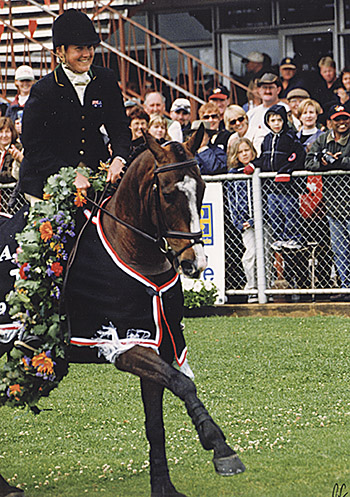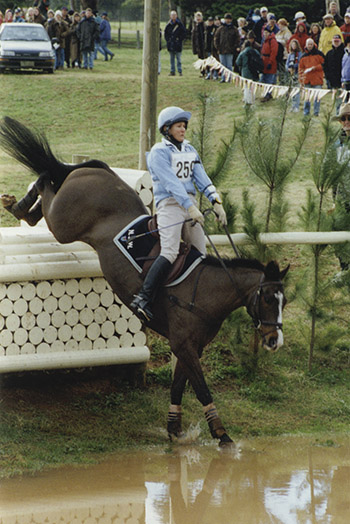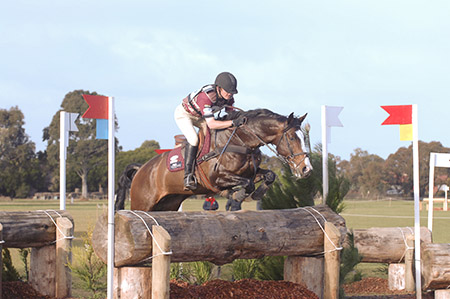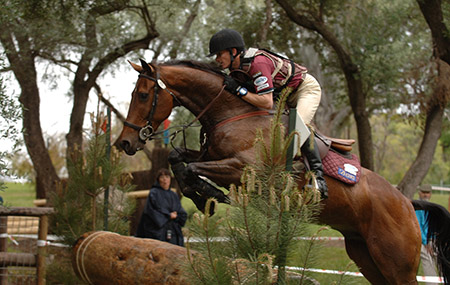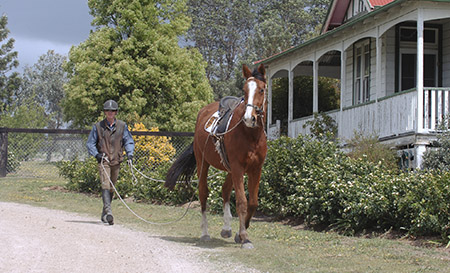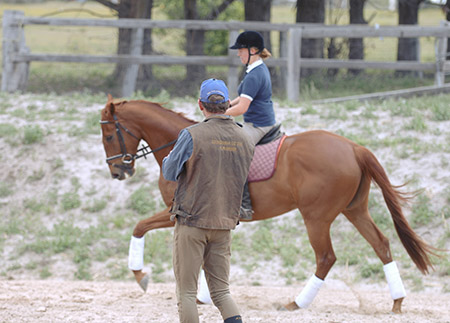Winning the three star at Adelaide in 1999 – Prue and Jackamin
Story – Chris Hector & Photos – Roz Neave
After the disappointment of being so close to a medal at The Hague, Prue did everything right in the run up to the Sydney Games, with the most unlikely candidate for eventing honours, the little Thoroughbred, Wendella Jackaman:
“The whole thing with Jackaman was a bit of a fairy story. Henry Hicks bought him for his wife Helen when he’d been celebrating at a country race meeting. He swore he was 16.2 when he bought him but he was 15.1 when he got him home! Helen sent him to me to ride when she was having a baby, it was their idea to take him Novice, so I said, okay.”
“He won three Novices straight up, then he went Intermediate straight away. I said – ‘oh yeah, he’ll cope with Intermediate’, and they were a bit nervous about that. Then I took off and went overseas with High Opportunity in the run up to the WEG in Rome, and so Jackaman didn’t get worked. Then when I came home I took him to the first event in the Holden Series, and he won that at Kooralbyn, and with that win, I started to think, ‘this could be quite serious’. That was the turning point.”
“He was amazing. He is the most amazing ride cross-country. If I thought it, he did it. He definitely had the benefit of more years of experience on my part too. Navarone, he copped a real amateur rider and he still went to the world championships! Hopefully by the time I got to Jackaman I had learned a bit more…”
Magic cross country – Jackamin on course at Werribee in 1999…
Then six weeks out of the Games, Jackaman developed a life threatening illness, for weeks the vets battled to save him, but Prue’s hopes of competing for her country, in her country, were gone.
“By the time the Sydney Olympics came, that was a terrible disappointment. I always felt dreadful that something had happened to Helen and Henry’s horse, but when you look at the big picture, it was pretty phenomenal for the horse to go as far as he did. And now he has recovered, Helen is riding him, and he’s doing medium / advanced dressage…”
But it could have been a gold medal on the mantle…
“It would have been nice. I can remember walking the course at Sydney and I was missing the feeling of him going up another level. I’d ridden him from Pre-Novice to Novice and he just did it like that. Novice to Intermediate, whenever you went up a grade, you never felt the transition. I remember when he missed out on doing the 4 Star, I thought, it would have been so good to have that feeling on him, because I think it probably still would have felt like riding Pre-Novice. You can’t describe that.”
“I remember well after Sydney, when he was back in work, Helen sent him to me, and I thought – ‘oh I’ve just got to jump him a little bit’ and I came down to this double and BANG he just left the ground. I thought, see I wasn’t having myself on, this horse is just a jack in a box. Really genuine.”
So do you have ambitions of finding another one of them – another international competitor?
“When you have had one that was so good… they’d have to give you that special feeling to try and do it again.”
But are you happy at home with the babies?
“I am happy at home no doubt about it. Who knows what horse is going to come up. You’ve just got to have that feeling. I’m not out there hunting for a three or four year-old to take me to the next World Champs, not actively – I’ve got Staccato wound up now to do a bit of dressage, and that’s exciting. I’ll probably get shot down in flames for saying dressage is easier, but it is easier with the children. Going to an event is like a military exercise, whereas the dressage, the longest I’d have to drive is to Sydney, two and a half hours. I can do the whole competition in a day and come back. Logistically it is easier for me. Craig tells me I am allowed to go Medium this year, as long as I go Prix St Georges, next year.”
“I’m definitely still competitive, I’ll never lose that. I’m stoking up to do dressage – I’m not going there to do a bad test that’s for sure.”
Craig and Prue’s stallion, Stakkato, on course at Werribee. Stakkato currently leads the official World Breeding Federation for Sport Horses stallion standings for eventing.
Craig are you still looking for the international superstar?
“Absolutely. I’ll definitely ride for Australia, that’s pretty much the reason why we still do it. I think riders like Andrew Hoy and Clayton Fredericks, they inspire you. I’m not saying they are old, but Andrew’s not getting any younger, Clayton has been around as long as I have. No one ever stops looking for it.”
And now you are trying to breed them yourself?
“I enjoy the breeding. I would like to think that we can produce homebred Olympic Games horses. That’s definitely a goal. You’d love to ride one, but I’m not saying I’m not going to ride them if we didn’t breed them…”
When will the first of your breeding program come on line?
“I’ve got Sandhills Marnie CHECK, he just won the 3 Star One Day event at Scone and Stewart Tinney has a mare, Panmira CHECK that has just done a 2 Star 3DE, and you can just bet it will be 3 Star next year. They are up there and running. We still sell them, so it’s the ones you can’t sell that we keep and train and get to Advanced level.”
Sandhills Marnie and Craig – Adelaide 2005
“Like Sandhills Benson, the one in our little breaker session – I think he could go Advanced. He’s very much thrown to the Thoroughbred in the way it wants to behave. It’s sharp, it’s quick, but it is in a bit of a Warmblood’s body, so you will canter down the centre line and you won’t have to be flapping or kicking to keep it going. And thanks to its breeding you will have a double handful on the cross country because it will want to go – but you will have the scope of a Warmblood jumper, a bit more rideability than the hot Thoroughbred that has been on the racetrack. Plus you’ll have a bit more ‘gee he’s a nice mover’ in the dressage.”
“That’s what you need now. If you don’t have something with an 8 for a walk, 7 or 8 for the trot, and an 8 for canter, staring you in the face as a two-year-old, you are not going to improve it. What the dressage judges in the eventing are saying is – I don’t want to put words in their mouths – but it is almost like a young Dressage horse class. It’s got to move nice, it’s got to look lovely, and it’s got to be soft to ride, rah rah rah. Again I’m treading on dangerous territory, but I don’t believe the eventing dressage judges are rewarding collection, not rewarding real dressage training unless it is in a very nice package.”
“I could get shot down in flames for saying that sort of thing but I have just watched the Badminton dressage tests and I think they are riding much more like pure dressage, much more active than they used to be. The trot is a little quicker, and the canter is a little quicker and they are a little bit more lively and that’s the way you’ve got to go with the higher level dressage movements.”
“Unless you have the horse that is going to give you those marks straight up, I don’t think you are going to train it to do a good enough trot, don’t think you are going to get away with a bad walk, or an average canter. Now I’m talking about Olympic Games horses here, and if you are trying to pick one now, you’ve got to be a lot fussier with their paces than we were in the past.”
Prue: “You can’t score a 35 when the horse is never going to be better than a 5. That’s the bottom line, if you are going to need an 8 walk, trot and canter AND you’ve got to train it well.”
BREAKING IN
If you breed horses, one day they have to be broken in. When we visited, one of Craig’s tasks for the day was working with the three-year-old.
“We bred him. He’s out of a mare by Pride of Killeena. The mare was apparently a bit difficult to ride, but I like the breeding because there have been some good Pride of Killeena jumpers in Queensland. Kevin McNab had Taj Maraj – who went round Adelaide countless times with him – she was a lovely jumper. This is the first foal for this mare, it’s three-years-old now. I’ve been breaking it in very slowly – it’s our horse so it goes to the end of the list each day, and just gets worked when I can get to it.”
“He’s just got a fantastic walk and trot, super canter. It’s always good when once you get on and ride them, they are still nice. We’re just hoping he does the job, because breeding eventers is a bit of a lucky dip. There’s a lot of variables you’ve got to cover – there’s infinite possibilities and combinations.”
You like to long rein the babies?
“I like to long rein them simply because you need to be able to turn and stop when you get on them. I also like to long rein them in the open, because some of them when they get out in an open space and they get a fright, they go – and you don’t want to be sitting on them unless they stop and turn. It just lets you know what they are going to be like when you take them out in the open.”
You have to be careful with long reining – especially with babies you can be so strong that you can tip them over?
“If you do that, you’ve been too tough. I certainly don’t get to that point. We don’t use side reins when break them in. We only turn them. We don’t necessarily mouth them in the traditional sense. We only get them to stop and turn, and I think that stops a lot of the panic. If they are not fixed, they don’t tend to panic as much. Long reining is just a good way of knowing what they are going to do when you get them out, before you get on them. You can put a little bit of pressure on them, you can let the ropes flap around their back legs, you can pull them around. They can get a fright and you are just not up there on top of them, ready to go.”
“It’s just a way of putting some pressure on, before you get on them, to see their reaction.”
And you make sure you don’t get your face kicked in, like poor Shane Rose?
“Poor Shane, that was horrendous. Absolutely, I was doing the breaking in probably a week after he went to hospital and I was on a young horse – third ride – and I just cut a few corners and just took it a bit cheap. I was in a hurry and this horse took three steps of walk and absolutely let drive – it went up so high that when it came down it crumpled on landing, and I thought, right. I’ve swung my leg over to get off, but the adrenalin was pumping so fast that I’d hung on to the pommel the way the buckjumpers do when they buck – I got off, but my right hand was stuck on the pommel. I’m going, ‘this can’t be good’, and it’s bucked again, my hand has gone up with the pommel and the saddle, and it’s just come off, and both back legs came straight at me. One got me on the shoulder and the other one got me on the ribs, and all I could think of as I saw them coming was Shane.”
“It happens so easily. It is a dangerous game breaking in. I don’t do a lot of it. At the moment I only do horses from people I know. Horses that have had some handling. The Thoroughbreds who have been through the yearling sales are fine because they’ve had a lot of handling. The worst ones are the ones that have never seen a white man. They turn up on a cattle truck and don’t have halters on. You just don’t want those – you leave those to the real pros.”
“I just do the ones that are going to be easy. I like the dressage ones. Two year olds that have been handled a lot by their owners. People say they spoil them but for breaking in, they actually do a wonderful job – you can flop all over them and they just think you are spoiling them like the owner did…”
Craig takes a lesson with Jess and Raquel Robson
It was time to try out the new arena at Sandhills, and while the howling wind was doing its best to make the place live up to its name, there was no doubting the focus of the two young riders on the surface. Two sisters, Jess and Raquel Robson on a lovely almost matching pair of chestnut ex-racehorses – Forrest and Sincere Magic, or Reggie as he is known at home…
They are the sort of pupils every trainer would love to teach – dedicated, disciplined, and trying ever so hard to get it right. Fifteen-year-old Jess is riding Reggie, the more recent refugee from the race-track, not that Craig works any softer on her on that account, although he admits that this one is ‘a bit more difficult to persuade he can do dressage…’
Thirteen-year-old Raquel’s horse is a real little star and ends the session demonstrating flying changes on a twenty metre circle from true canter to counter canter!
“Raquel and Jess Robson – their mother rode and she was a really keen rider, she used to bolt around the streets of Branxton and Greta, wild as all getup. Jess is a very good rider, if you had a difficult horse, you would always put Jess on it. She has a natural ability to let the horse do what it wants to do, and look after it really nicely. Right now Jess’s horse is out, so she is riding one of her mum’s horses – a five-year-old that was a bit feral for her mum. I said to her mum, just keep Jess on the horse for another six months and it will be right to go.”
“Raquel is 13. I’ve taught her for a couple of years now. Prue started teaching them, then they transferred to me because Prue was having babies and all that sort of thing. Raquel has a really nice Thoroughbred horse – just one of those very trainable ones. Raquel is in the mould of Sammi McLeod, Kristy Oatley-Nist! At 12-13, she is riding flying changes and half pass. She has just come 7th at her first 3DE – in Pre-Novice at Sydney, the best placed young rider in that class.”
“Today is just a normal flatwork lesson. Just basic dressage with Jess’ horse, just round even rhythm – no rocket science. Just establishing an even rhythm in the trot and canter – he’s a Thoroughbred who wants to go, a bit difficult in his frame. He’s a bit naturally upside down, doesn’t like being round. We just work on that. Jess has done a super job, six months ago you couldn’t get him round. He’s a real tough character, you try to make him do something and he just says ‘no, I don’t like that!’ So she has just chipped away at him, and done a nice subtle job. He’s now round with a nice trot and nice canter, it’s a little bit free but for the stage he is at, it is perfect.”
“With Raquel, you’ve just got to try and remember she is only 13. She does flying changes, she rides through all the exercises I have advanced riders doing at Squad Schools. She is just an amazing talent and there is no reason her horse can’t go Advanced. Her mum has heart failure when I tell her that, but Raquel is one of those lucky ones who have a super horse at that age – a bit of a Wendy Schaeffer situation. They get the horse when they are young and go all through the grades with it, by the time they get to Advanced level, they have done it so slowly that they never ever frighten the horse. At every point they are champing at the bit to get to the next level – she is not old enough to go Novice, but she trains over all the Novice jumps at Lochinvar. By the time she is old enough to move to Novice she’ll be well and truly ready for it, same when she goes Intermediate, they will be indestructible by the time they get to Advanced.”
After the lesson:
What were you trying to do today?
“With Jess’ horse, he’s younger and we were just trying to do relentless rhythm, rhythm – we almost try to bore him a little because he doesn’t cope with being told what to do.”
Is that a racehorse thing?
“Absolutely. I think you’ve got to let them relax, the good riders can do it quicker, but Jess is doing a really really good job of letting him relax with not a lot of pressure. Still making him do the things we want him to do. He did a little counter canter there today, he did the short side in counter canter, and had good balance. The canter itself was shorter than it has been, so she is making a real improvement without a lot of pressure. That’s all we can expect from him.”
And the other horse is pretty flash?
“The other horse is really really fancy and Raquel does a fantastic job. Yes, the horse is not perfect on the bit, it doesn’t have the perfect bend in the shoulder in and half pass but the fact that I can say to her, shoulder in or half pass, and she understands about the inside leg and the outside leg – and the inside leg and the outside rein. She understands riding a flying change… that blows me away for 13, if I’d had that sort of training when I was 13…”
“I just keep Raquel chipping through all those movements so that by the time she gets to Advanced, they’ll be like riding walk, trot and canter. We’ll definitely want the horse to be a little softer, a little rounder. He was a bit tight off the aids today, jumped off the leg like a little Thoroughbred would, but really with Raquel it’s making her feel that she can compete with the best of them. The medium trot just gets bigger and bigger, the horse is really elastic, really powerful, has lovely expression in the changes. It is just a matter of keeping Raquel confident, confident she can take on the really good guys.”
“It’s not about teaching them to ride, it is more about showing them the path that they have to take to get where they want to go. Yeah I’ll teach them to ride as we go along, but the hardest part is picking them up when they fall off, or have a stop. Raquel went to Jump Club a couple of weeks before she went to Sydney, and the course builder racked up the metre five class to a metre fifteen, and she had a couple of stops and was eliminated. We had to fix that. We fixed that, and when we went to Sydney, she had a good round in the showjumping.”
“It’s those sort of things that you need to get onto quickly before they are a problem. Those kids can ride – gee they can ride. They have a good natural feel and it is just about educating them, what their legs do, what their hands do, just showing them the way, and giving them good information when they need good information.”
“Which events to go to, which events not to go to. People can get burned because they go to the wrong event, because the course is too hard. As an experienced rider, they come to me for that sort of advice. When should I jump from Prelim to Pre-Novice? I’ll control all those things until they go Advanced, and sometimes you tell them they should go Advanced when they don’t feel they should go Advanced, but they look ready, and you tell them they are doing everything the right way and give them confidence to go and do it.”
“Other times you have to hold them back… that’s just your job as coach, keeping them heading on the right track. Confidence is the biggest thing for the rider, the horse is there, it will do it if we train it well enough.”
“One of the major jobs of the coach is to pick up the rider and keep them going. I think that’s something we got from Heath Ryan when we trained with him at the Centre – he picked us up and took us where he’d been and where he was going. You feel that’s what you want to do for the kids you teach. You want to take them with you… If I can help get them to where they want to go, that’s great.”
This article originally appeared in the May 2007 issue of The Horse Magazine



